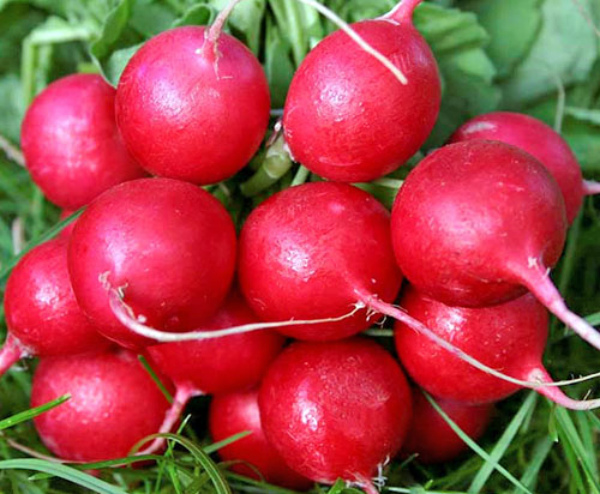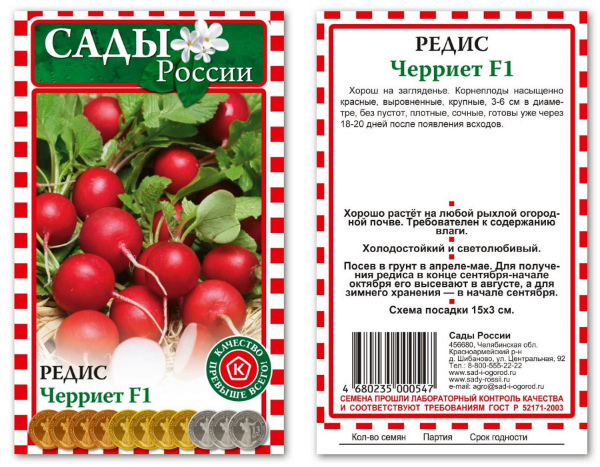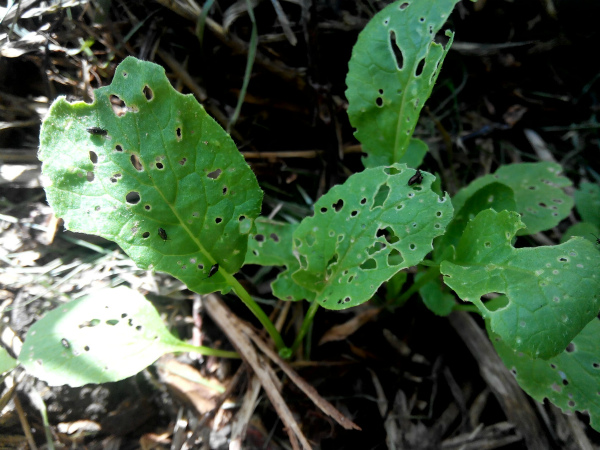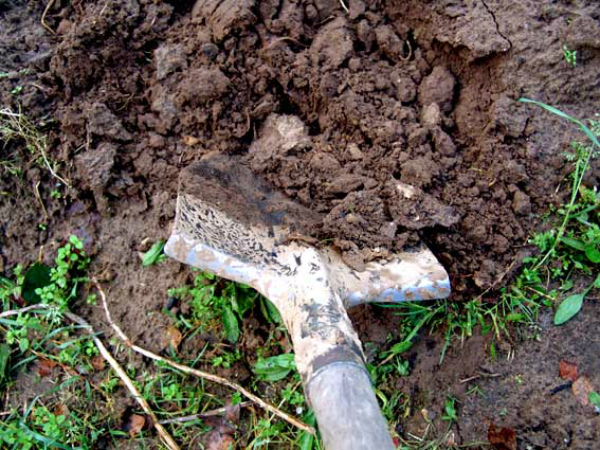Radish Cherriet: description and features of the variety
Content
Description and characteristics
Cherriet is a hybrid form of early ripening radish. In favorable conditions and subject to agricultural technology, the first crop can be harvested in 16-18 days from the moment of emergence. Like most Dutch radish varieties, it has a high immunity to cold and easily adapts to any climatic conditions. Under a film cover, radishes can be grown from early spring to late autumn. In winter, the crop grows well in greenhouses, but the ripening period is slightly delayed due to the lack of daylight.
The advantages of the variety include high resistance to diseases and damage, the absence of voids in roots, even when overgrowing. It should also be noted that plants are not prone to the formation of arrowheads with peduncles. They have a compact leaf rosette, and therefore radishes can be planted more densely than other varieties, which saves planting space.
Cherryet hybrid is highly valued by vegetable growers and consumers for its excellent taste and good marketability. Root crops of this variety are distinguished by a surprisingly flat surface, the same rounded shape and an intense scarlet skin. The pulp of root vegetables is white, dense, very juicy, with a medium-pungent taste. The size of root crops in removable maturity reaches 3-4 cm, but with good care they can grow up to 5-6 cm. The average weight of fruits is 25-30 g, large specimens reach 40-45 g. Radish is perfectly transported and stored for a long time refrigerator can be up to 1 month.
Growing features
Cherriet radish is very cold-resistant. It can be sown in a greenhouse or under a film at the end of March, and in open ground - as soon as the soil warms up a little, in early or mid-April. When planting radishes in the garden, try to place the garden in a sunny place, since in the shade the plants will grow long tops, which is not typical for this variety, and the roots will be small at the same time.
For good yields, radishes need fertile and light soil. It is good if loose sandy loam soil with neutral acidity or slightly acidic predominates in your garden - this is the most suitable soil for a crop. If you have heavy soil, you need to add peat, river sand to it, to increase fertility - compost, humus, to reduce acidity - lime or ash.
Keep in mind that radish does not tolerate fresh organic matter (droppings, manure), as well as nitrogen mixtures.
Since the growing season of Cherryet radish is short, it does not need additional fertilizing - as a rule, the fertilizers that were applied during the preparation of the soil are enough. If it seems to you that the radish does not grow well, pour it with an ash solution (1 cup / 10 L of water). Ash contains potassium in an easily accessible form, which contributes to the rapid filling of root crops and an improvement in their taste.
As for planting, the seeds of this variety can be sown without preliminary soaking, since their germination is very high. It should be sown to a depth of no more than 1.5 cm. If the seeds were sown densely, after germination they are thinned out, leaving a distance of about 5 cm between the seedlings. Radishes are hygrophilous, so you need to ensure that the soil at a depth of 8-10 cm is always moist. The optimum temperature for the development of root crops is considered to be + 16–20 ° C.
Flea protection
As mentioned above, Cherriet radish has a high immunity to damage and many diseases, in particular fungal. However, its young leaves very often suffer from cruciferous flea beetles - black bugs jumping along the bed with shiny backs. The parasite belongs to the family of leaf beetles, it devours young leaves in the upper layer, which, of course, affects the condition of the plants and often leads to the destruction of the entire bed.
It is impossible to use insecticides for radishes, since root crops quickly accumulate these chemicals in themselves, so folk recipes remain the only way to deal with the flea.
For spraying plants, you can prepare the following medicinal liquids:
- vinegar solution (1 tbsp. a spoonful of essence in 5 liters of water) - the leaves are sprayed on both sides in the afternoon or evening, when there is no sun and wind;
- tomato-garlic infusion (0.5 cups of chopped garlic and tomato tops per 5 liters of warm water) - leave for 3 hours, strain, add a quarter of a piece of grated laundry soap, spray the garden at the rate of 1.5 l / 1 meter of area 1 time 5 days;
- a decoction of tomato tops (2 kg of chopped green tops per 5 liters of water) - bring to a boil, then cool and filter, immediately before spraying, dilute the finished broth in half with water and add a quarter of a bar of soap, spray once a week;
- loose mixture of ash, makhorka and pepper (mix makhorka and ash in equal proportions, add a little young pepper) - spray the mixture onto the leaves after abundant watering once a week.
As you know, the best treatment is prevention. Fleas winter well in the soil, and next year, even if not radishes, but other cruciferous plants grow on this bed, the parasites will attack the plantings again.
A deep digging of the soil right before the onset of frost will help to avoid the invasion of parasites next year. The soil must be dug up so that all wintering insects are on the surface and freeze from frost.
An equally effective way to protect against an invasion of beetles can be the neighborhood of dill, coriander, potatoes, garlic or tomatoes - insects do not like these crops, and will be forced to leave the garden with radishes. Many vegetable growers plant marigolds or calendula in the garden next to radishes - the plants release special aromatic substances into the air that flea beetles also do not like.
Video "Hybrid varieties of radish"
Take a look at this short overview of hybrids and you will understand why it is better to choose new varieties of radish.





